4-Track Broadcast Recorder Operates as a 4-track or two individuals 2-tracks with solid-state media
หมายเลขสินค้า : HS-4000
ราคา 372,500.00 บาท
-
ตรวจสอบก่อน! ว่ามีสินค้าหรือไม่
-
*กรุณาโทรเช็คสต็อคสินค้าก่อนสั่ง 061-649-9144
เลือกจำนวน :
เลือกสี : สีเทา
|
4-Track Broadcast Recorder Operates as a 4-track or two individuals 2-tracks with solid-state media |
Latest firmware :V1.40
The TASCAM HS-4000 4-channel audio recorder is built for the needs of modern broadcast facilities. It captures four tracks to solid-state Compact Flash cards, and two cards are available for simultaneous redundant recording. Confidence Monitoring is available to listen to audio off the card while recording. The HS-4000 can function as one 4-track recorder or a pair of individual 2-track decks. In addition to recording and logging tasks, the HS-4000 includes On-air and monitor play modes.
Audio on the HS-4000 is captured as Broadcast WAV files, including a timestamp from the SMPTE input source. The transport can be controlled over RS-232C, RS-422, Parallel or LAN control. Balanced analog audio is interfaced through XLR connectors, and multi-channel AES/EBU digital I/O is available.
A color TFT touchscreen is used to change settings and view meters on the HS-4000, making the GUI simple to use. Three remote controls are available with a variety of flash start, transport and fader functions.
Main Features
|
Specifications optimized for flash starting by broadcasters |
- Lightweight and compact flash starting system
-
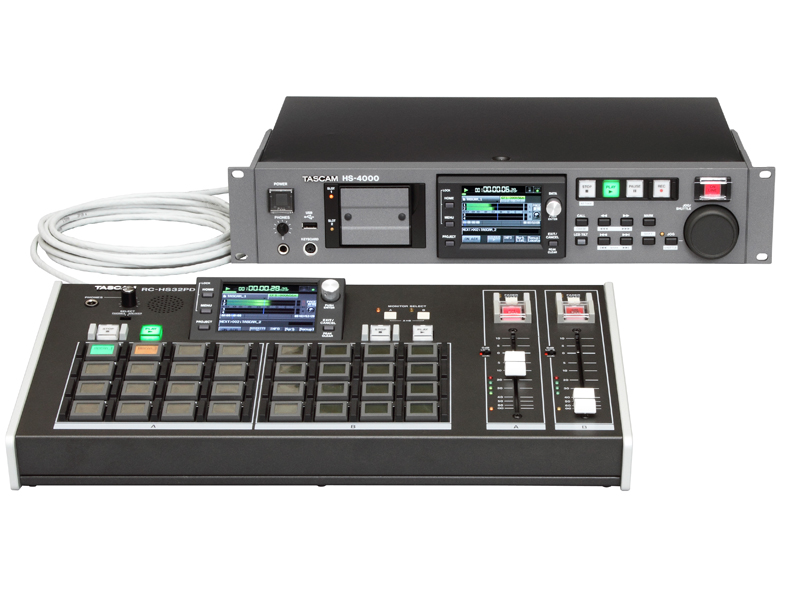
Most of the flash starting systems that have been used until now have been large, so when it has been necessary to move them between studios, the work of transferring them has been extremely difficult. In contrast, a flash starting system composed of our HS-4000 and RC-HS32PD units is extremely compact, making it a worry-free choice for use in environments where portability is necessary. - Efficient flash start operation with 2x2 playback
-
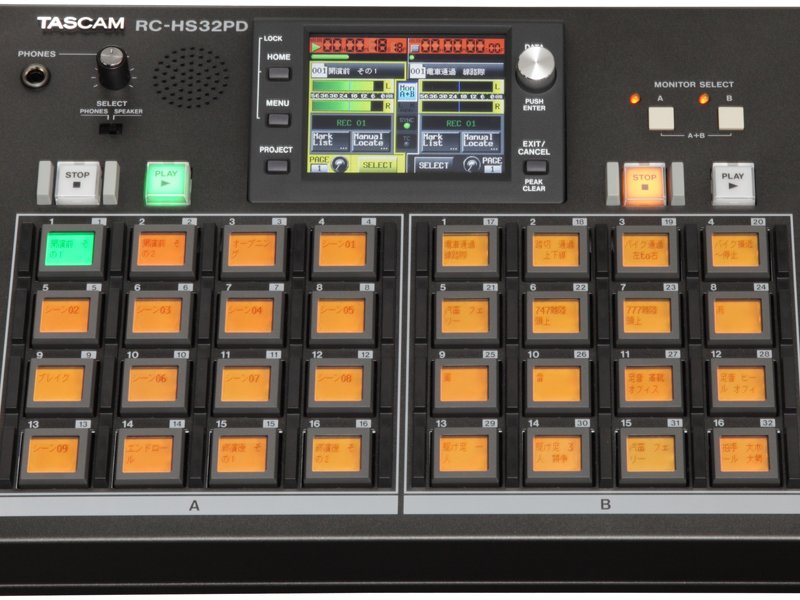
In situations where the use of two players and a controller are necessary, a setup composed of HS-4000 and RC-HS32PD one pair is extremely efficient, particularly in terms of space, cost and operability. This setup realizes efficient operation in a variety of situations, including when you need to alternate between two sets of background music, you need to flash start effects sounds while playing background music or you need to flash start different effect sounds at the same time. - Flash start keys can display file names making them easy for anyone to use
-
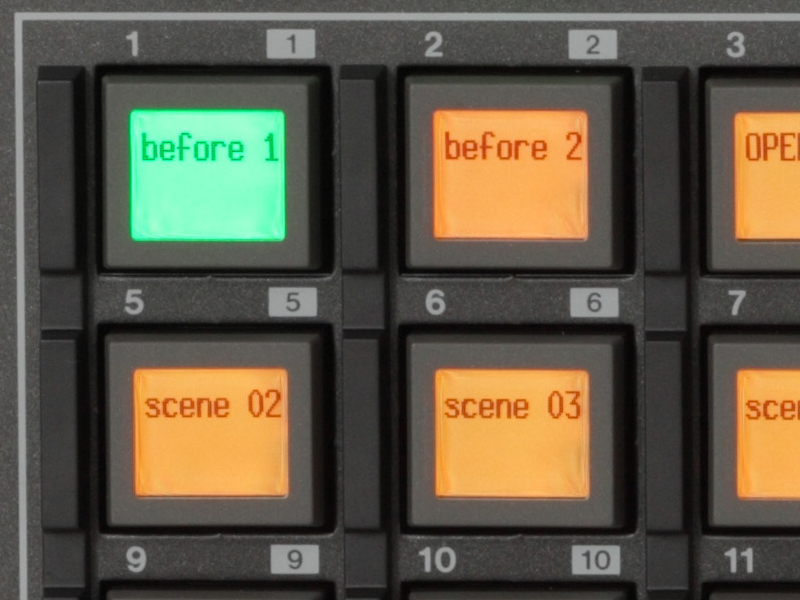
Each RC-HS32PD flash start key has a built-in 64x64 dot matrix LCD. Since they can show file names, flash starting is as “pressing the file name.” - The playlist mode is perfect for flash starting and PPL is also supported
-
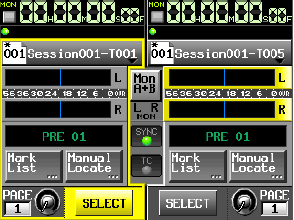
Since these units were developed not only for applications as recorders, but also considering operation as flash start players, a "playlist mode" is included that is an operation mode especially for flash starting. To use this mode, add the takes to be used to the playlist. You can edit the IN and OUT points and levels of each take, so this is convenient for making fine adjustments for flash starting to use after importing data. - Faders support fader-starting and have locks at 0dB
-
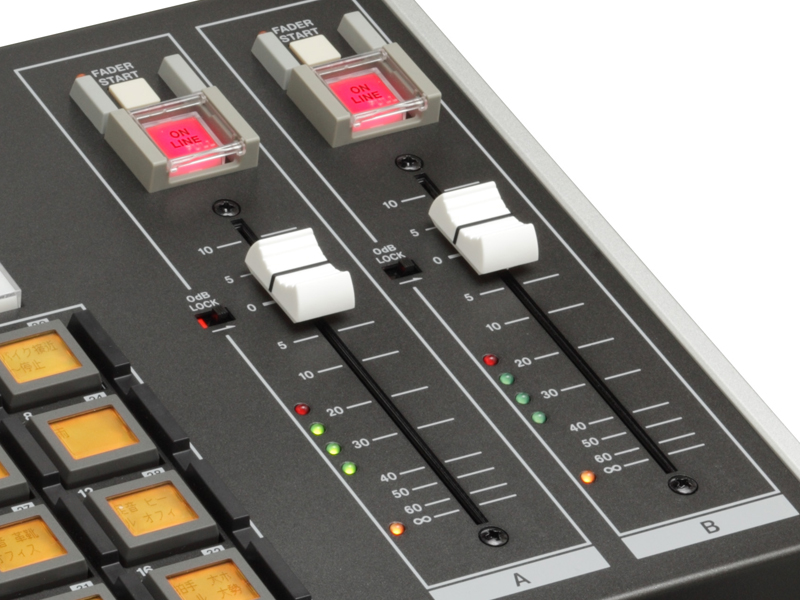
In addition to flash start keys, the RC-HS32PD has a pair of 100mm faders that support fader-starting as a form of transmission control. These enable complete 2x2 operation (with one HS-4000 functioning as two players). These faders also have physical 0dB locking mechanism. - Use in combination with an RC-900 transport controller
-
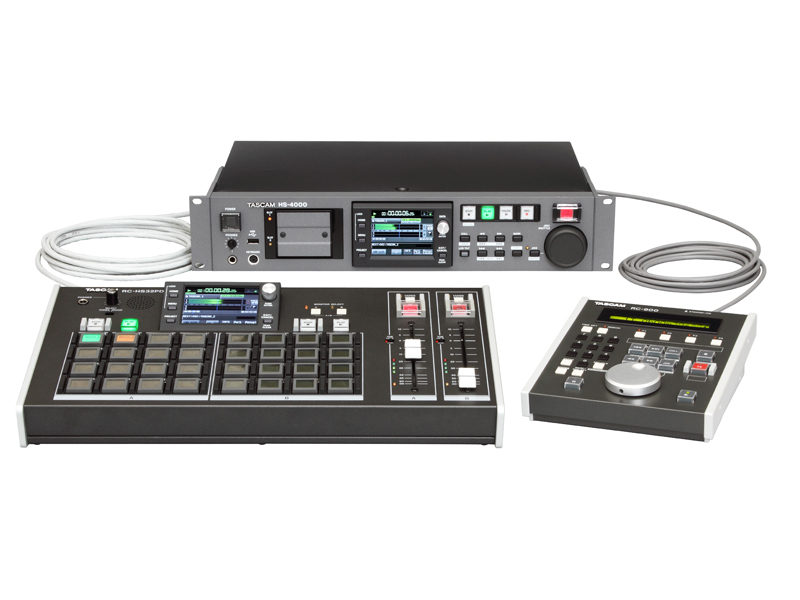
While using an RC-HS32PD as a remote control for flash starting, you can also use an RC-900 for control over the transport. Since these units prioritize response to the most recent command signal received, interface devices are unnecessary to connect them.
|
The pursuit of operational efficiency |
- Five operation modes that respond to the requirements of various conditions are included
-
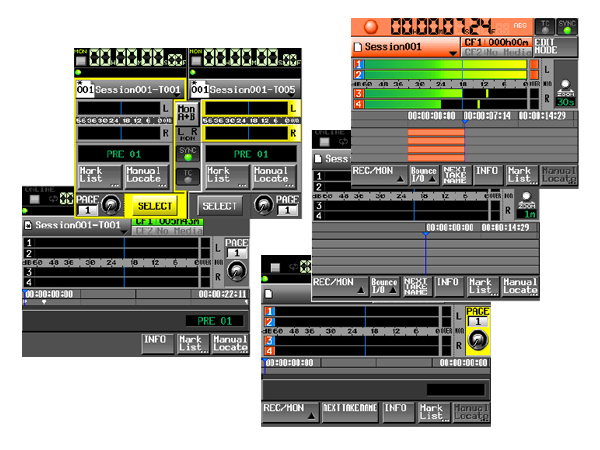
The definition of "superior operability" depends on the use conditions and the operator. The HS-4000 includes five operattion modes in order to respond to various conditions and user needs. - Real-time operating system (RTOS) created to resist infection and other threats
- For the operating system, we have adopted a real-time operating system (RTOS) developed for use with real-time applications. This OS can respond to various needs of broadcasters that ordinary PC-based systems are unable to handle. In addition to quick startup and speedy execution, which are crucial prerequisites, this OS also has great resistance against infection by computer viruses, which is a concern when connected to network and importing external data. Since you can connect these units to networks with peace of mind, the fundamental convenience of file-based operation has been fulfilled.
- Multiple remote controllers and a variety of external controls can be used together
-
You are not limited to just one remote controller or other external controller, but rather you can connect and simultaneously use as many as can be connected to the unit. Since parallel control is possible while an RC-HS32PD is also connected, by keeping both controllers connected at all times, in addition to the main flash start operator, other staff can conduct flash start operations and control emergency broadcasts. These units prioritize response to the most recent command signal received. Support for RS-422 SONY P2 protocol is also standard, making connections with existing control devices easy. 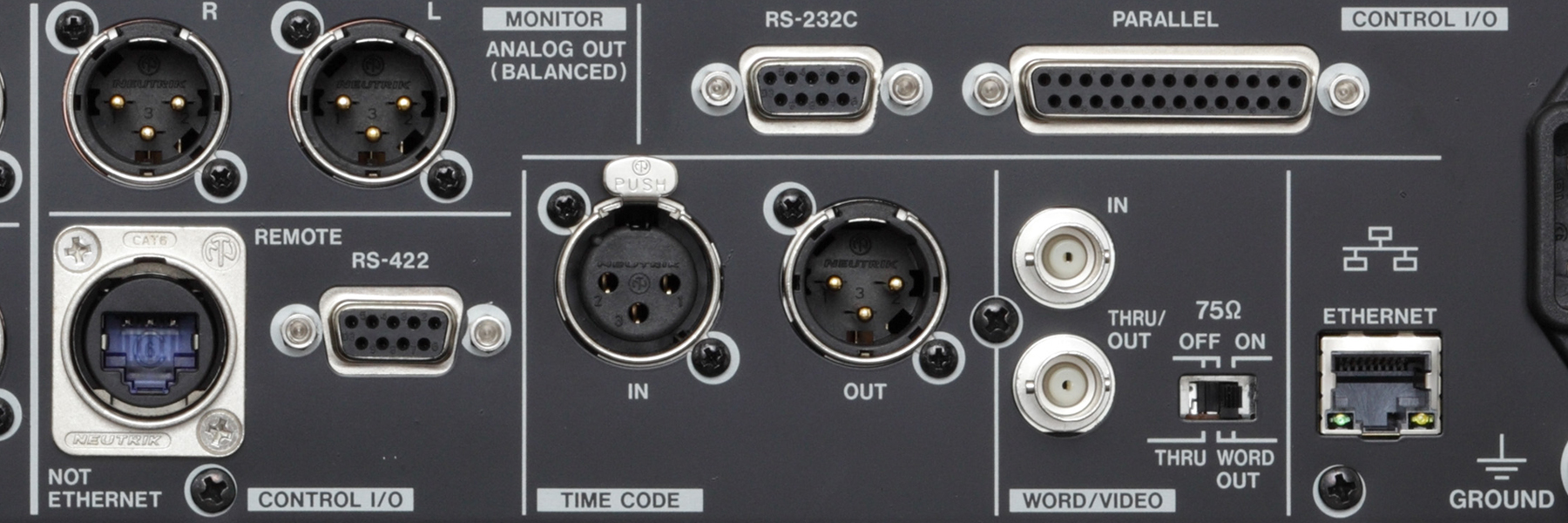
- Supports for Gigabit Ethernet enables flexibility and a wide-range of applications
-
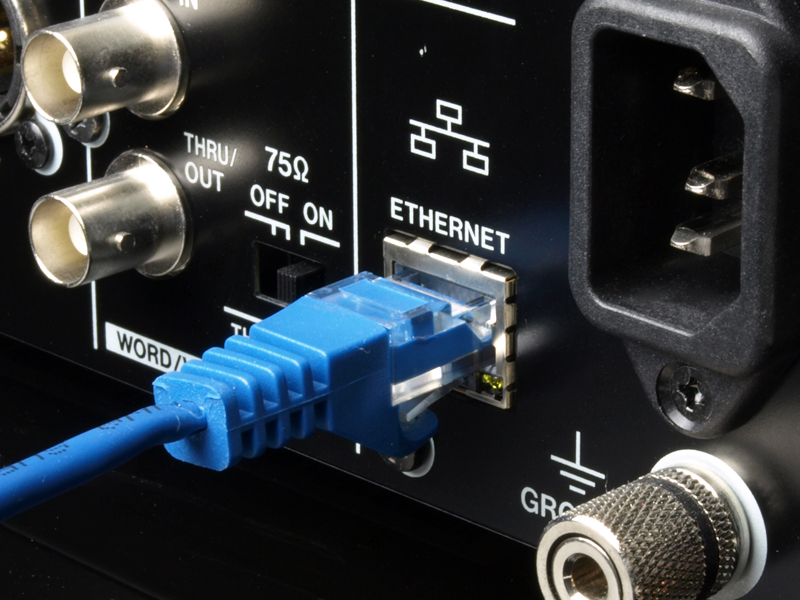
Using a network, even more flexibility and a wider range of applications are possible. With support for 1000BASE-T Gigabit Ethernet, these units use the common file transfer protocol (FTP), which is not restricted to specific systems. As a result, you can access these units from computers running Windows, Macintosh, UNIX and many other operating systems. Files can be transferred between CF cards and computers using FTP client software. Files sent to systems can be stored and otherwise worked with in a variety of ways. In addition, a telnet remote control environment that works over network is also supported. These features contribute to making user systems and workflows more efficient. - Focus on quick and stable operation and security to eliminate user stress
-
In addition to using RTOS, we have considered operational security from a variety of angles. ALL of the connectors include locking mechanisms to prevent accidental disconnection. Moreover, the power button and other important keys have button guards. When these guards are unneeded, they can be removed and the unit can be used without them. Of course, the unit also has a panel lock function. 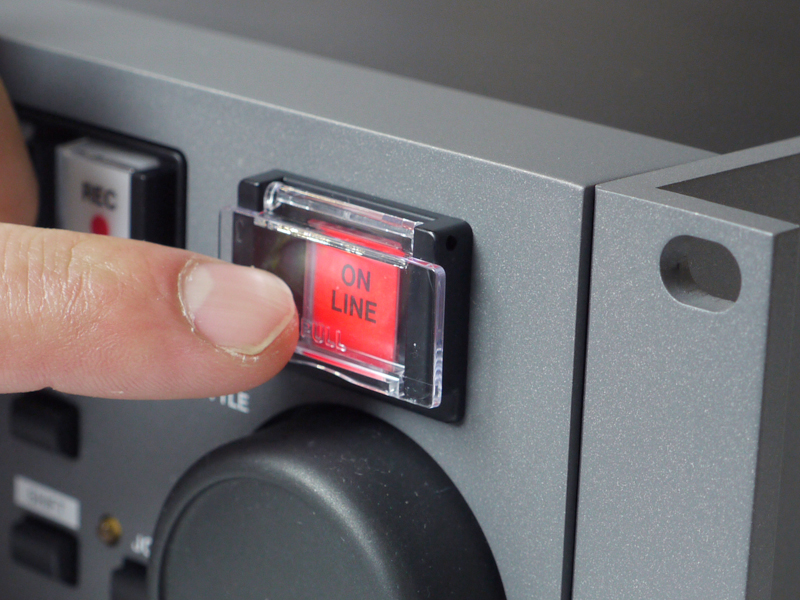
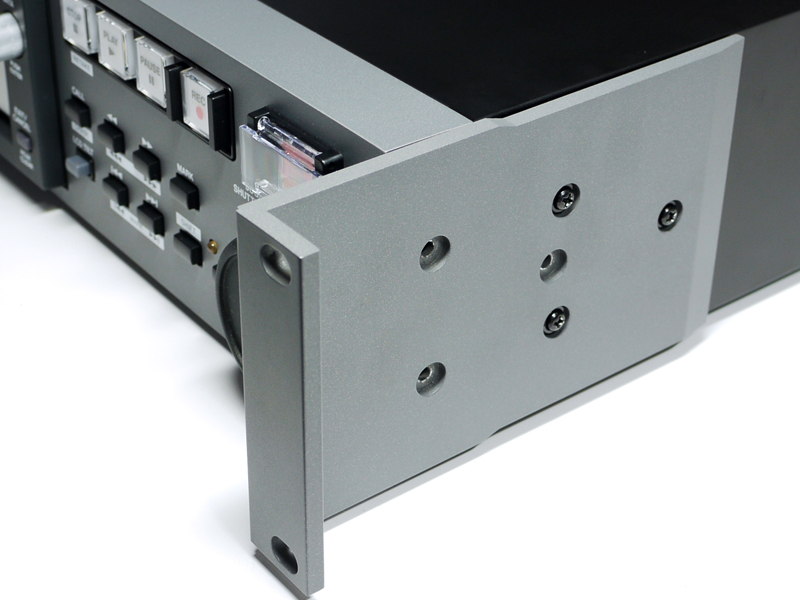
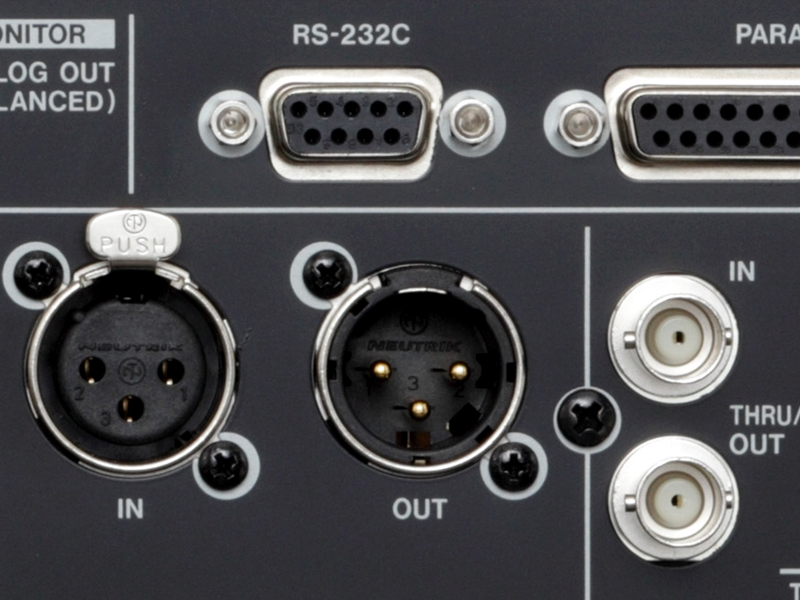
|
The pursuit of operability |
- Touch-sensitive TFT color displays enable intuitive operation
-
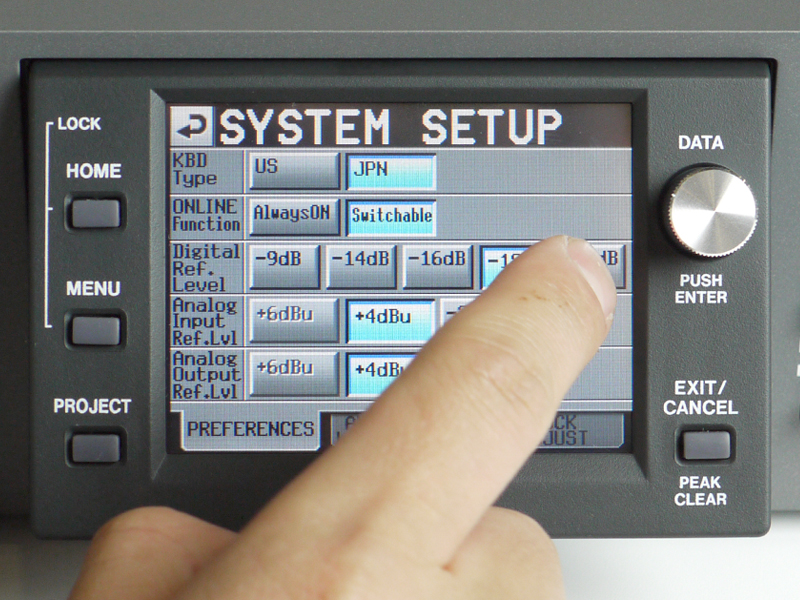
The graphical user interface shared by the HS-series enables intuitive and straightforward operation. The menus are sinple with only one level and you can return to the Home Screen with one touch when you complete making a setting. These units enable stress-free operation. - Built-in monitor speaker enable quick confirmations
-
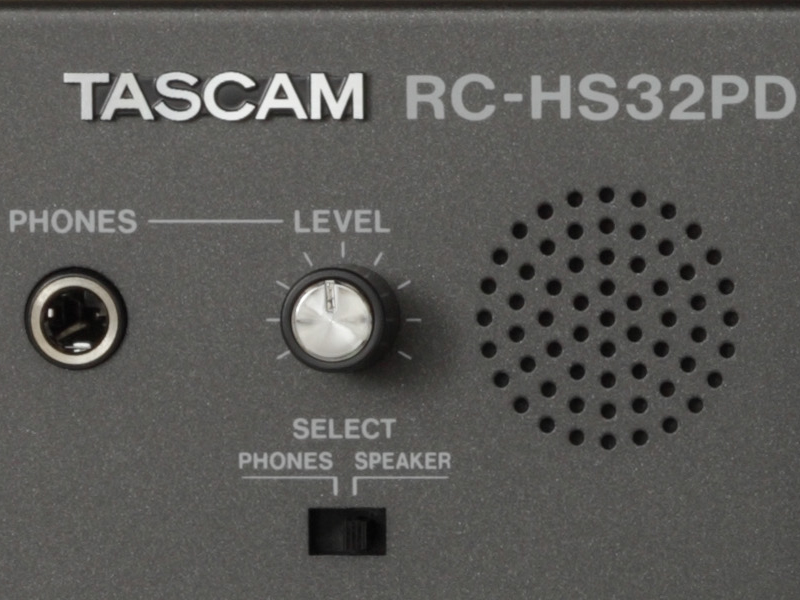
You can monitor audio even if the RC-HS32PD is located far away from the main unit or console. In addition to monitoring with headphones, these units have built-in speakers, so you can quickly monitor whenever you need to check something. - Support for VNC and the ability to use connected computers to check and control units
-
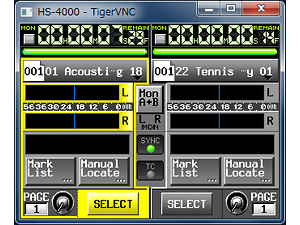
These units support Virtual Network Computing (VNC) over local area networks (LAN). You can view the screen of an HS-4000 on a computer connected to it on the same LAN. When doing so, you can also operate the unit's screen using a mouse.
|
The pursuit of durability |
- CF cards used recording media (Ultra DMA supported)
-
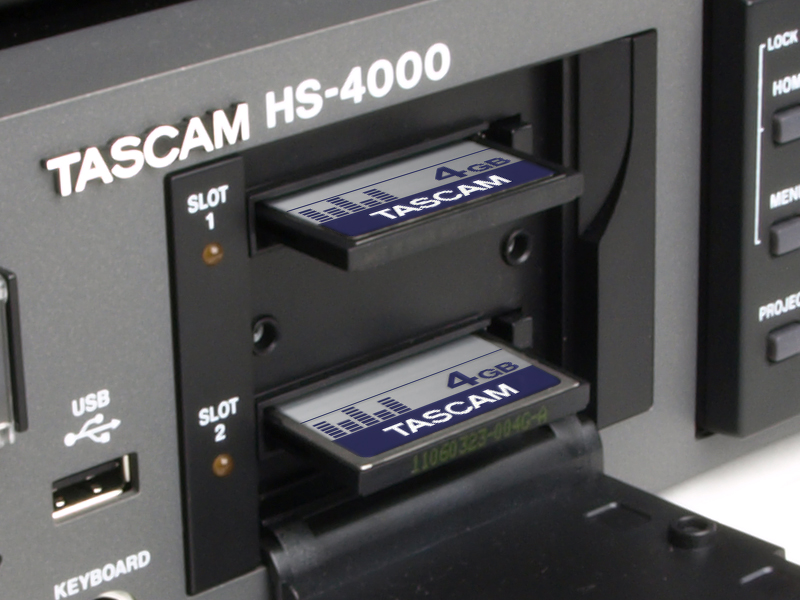
CF cards that boast high durability because their contracts are not exposed are used for the recording media. High durability also results from using media that do not require rotating mechanisms. This helps realize recording and playback equipment with the critical trait of high reliability as well as resistance to vibrations and other features that allow them to be used in all types of situations, including field recording. Since they require little maintenance, they reduce expenses over time. Moreover this type of media makes audio file management and utilization easy. - Independent circuit boards for each connector prevent contact defects due to twisting and other causes
-
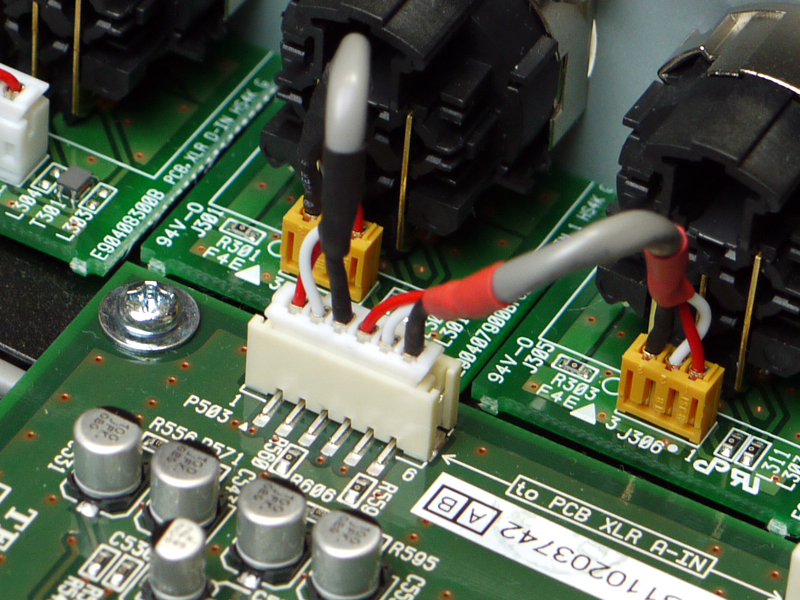
Since the layout includes one circuit board for each connector, not only do they boast excellent strength against twisting and pulling from cables, interference with other connectors is also suppressed. Since these systems are designed to be movable, if unexpected force is applied to cables when parts of the system are moved individually, their excellent resistance to these stresses can prevent accidents. - Tough CANARE's BNC connectors that are nut-tightened
- Unlike ordinary connectors that are fixed to circuit boards, the CANARE's BNC connectors used in the HS-4000 are individually secured using nuts, providing superior strength against pulling, twisting and other forces.
- High-durability knobs use metal even in their stems
-
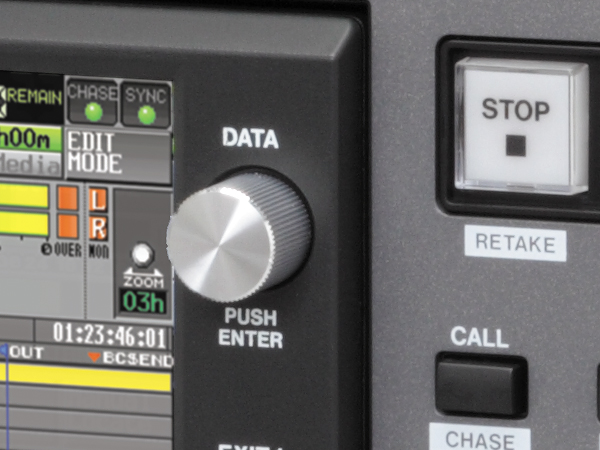
An aluminum materials is used in the HS-4000 DATA knob to prevent breaking and the reduction of operaility due to deterioration. It also makes helpful feedback "clicks" during operation. - Adopted aluminum side-panels for High-durability (RC-HS32PD)
-
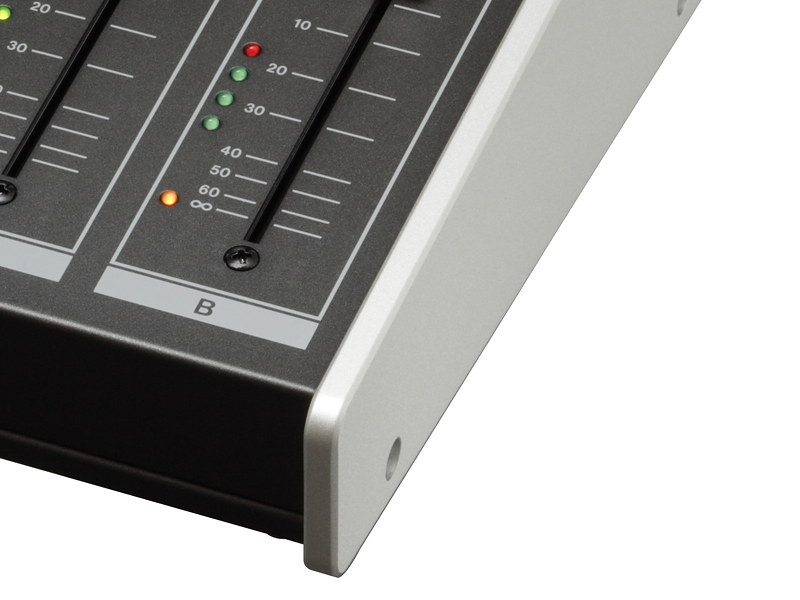
The RC-HS32PD adopted two aluminum side-panels for both side. These side-panels provide high-durability from crashing when moving these units.
|
The pursuit of high-quality sound |
- Components have been selected carefully through numerous listening evaluations
- In the development of the HS-4000 and other equipment with specifications that meet the demands of the broadcast industry, we have not only focused all the expertise that we have gained while developing professional audio equipment over decades, we have also conducted listening evaluations during the selection of individual components and made audio quality the standard when choosing parts. We conducted our listening evaluations in an audio room installed in our headquarters, studios and other locations.
- BurrBrown PCM1796 D/A converters and JRC NJM5532 operational amplifier
-
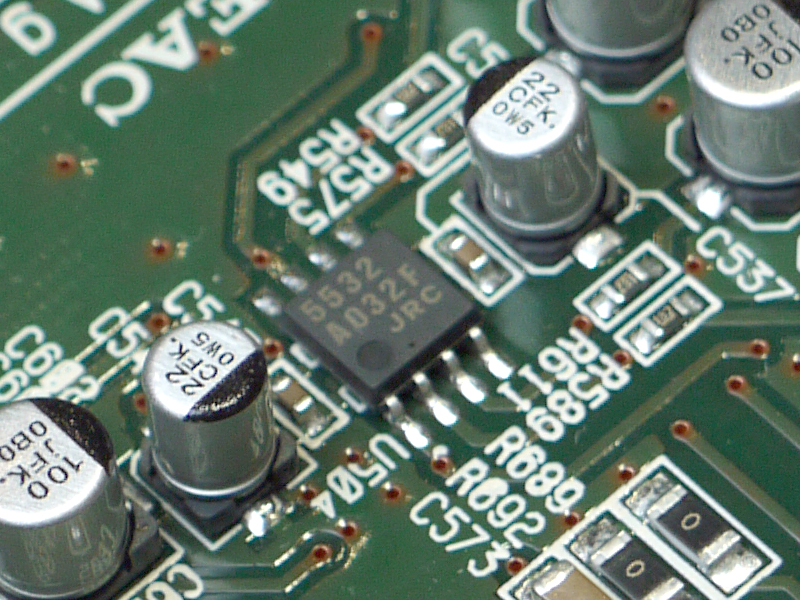
In these units, we used BurrBrown PCM1796 digital to analog converters because they have earned great praise for audio applications. We also adopted JRC's NJM5532 op-amps, which have a great reputation for audio, after listening evaluations. - Decoupling capacitors that contribute to power supply stability also selected carefully
- In audio equipment, a stable power supply is indispensable for providing high audio quality. We also conducted listening tests numerous times for the decoupling capacitors (bypass capacitors) that provide power to the audio circuits in order to select the ones that contribute the most to the audio quality.
- Power sections use high-capacity capacitors and achieve audio quality and high efficiency in compact spaces
-
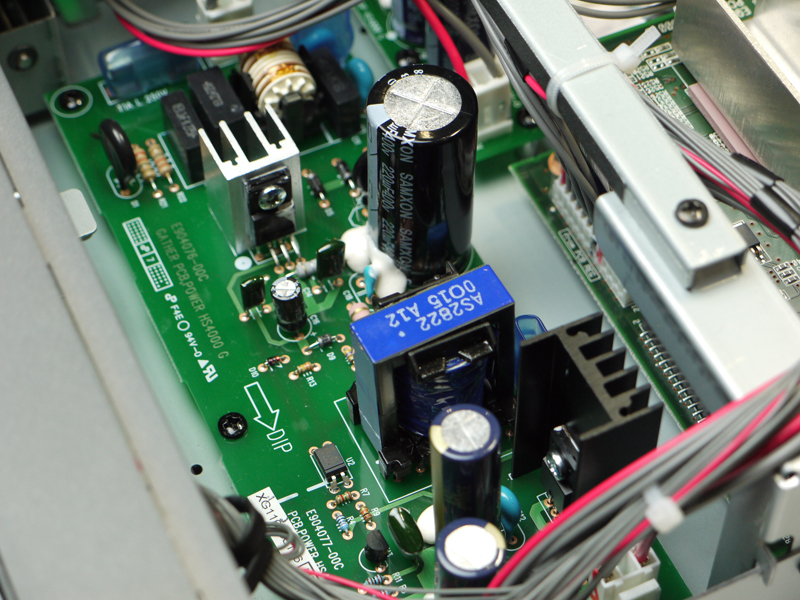
The power sections use high-capacity capacitors in order to provide stable power supplies. For specifications that meet the requirements of the broadcast industry, in addition to providing high audio quality, we have also pursued the creation for power supply sections that are compact and very efficient. As a result, these units offer high audio quality in a compact 2U rack siz. - NEUTRIK's metal-plated connectors allow little sound quality degradation over time
-
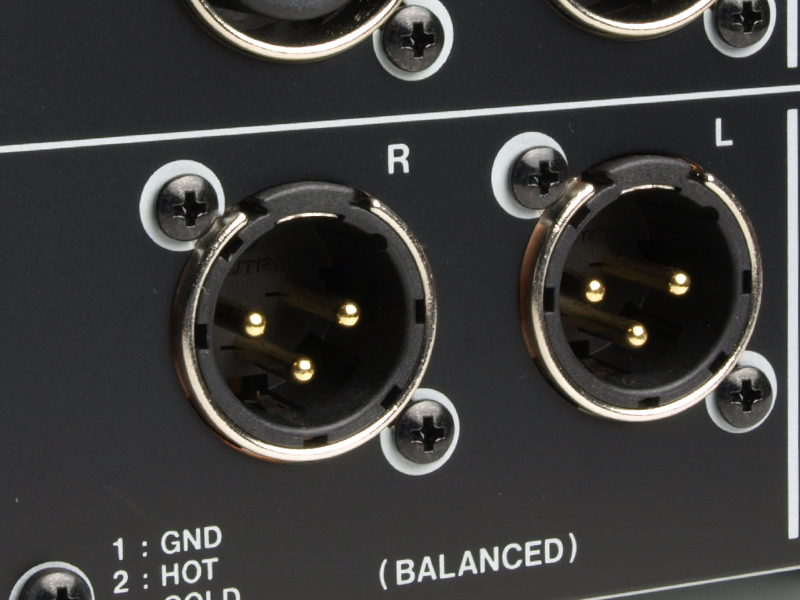
These units include metal-plated XLR connectors made by NEUTRIK that resist oxidization even over long periods of use and maintain high audio quality.
|
Features |
- CF cards used as recording media (Ultra DMA supported)
- Dual CF card slots
- Simultaneous recording of up to four 24bit/96kHz
- Confidence monitoring function (playback while recording) can be used when recording two tracks (44.1/48kHz)
- Simultaneous playback up to 4 tracks or 2 stereo tracks (in dual playlist mode)
- Five operation modes: timeline, take, single playlist, dual playlist and on-air
- In timeline mode, recording and playback like a tape recorder is possible using a linear timeline
- In take mode, playback and flash starting in take units is possible
- In playlist mode, takes can be added to a list for playback in list order and flash starting
- In single playlist mode, playback of up to 4 tracks is possible
- In dual playlist mode, 2 stereo tracks can be independent played back and controlled
- ON LINE key can be used for on-line playback and monitoring playback
- BWF and WAV file formats supported
- RC-HS32PD and RC-SS20 units (sold separately) can be used for flash starting
- Flash starting using parallel control and keyboards is possible
- Auto cue, auto ready and incremental play functions
- AES31 editing information can be imported and exported in timeline mode
- Playlist function in playlist mode (PPL supported)
- Jog and shuttle functions
- Intuitive operation is possible using graphical interface on TFT color touch sensitive screen
- Four XLR analog balanced In/Out
- Two stereo pairs of XLR AES/EBU digital In/Out
- Two channels of XLR analog monitoring outputs
- Headphones output
- XLR timecode input and output
- BNC video reference (NTSC/PAL black burst signals and HDTV Tri-level signals) and word clock In/Out/Thru
- Compatible with 48kHz pull-up/pull-down operation
- LAN (Gigabit Ethernet) supports FTP file transmission, telnet remote control and VNC
- Parallel remote control
- RS-232C serial remote control
- RS-422 (9-pin serial protocol) serial remote control
- Rack mounting possible (2U)
Features added in Version 1.05
- Recording function in tale mode
- Support for simultaneous input of PLAY and RECORD signals from an external device
Features added in Version 1.22
- Automatic recognition of external files
- Manual locating based on timecode time now possible in take mode and playlist modes
- Playlist mode changes to ADJUST screen operations and addition of rehearsal playback
- Assignment change function on the ENTRY list screen
- Change BC$STANDBY/END range at once function
- BC$END operation mode setting
- System setting backup and preset memory functions
- Take copy function
Features added in Version 1.40
- Support for P2 Vari Pitch commands
- Support for the importing and playback of ADL files that have two files attached to them
- Support for MECHA STATUS SENSE, CURRENT TRACK (TAKE) TIME SENSE and IMPORT ADL telnet commands
| HS-4000 | HS-2000 | |
| Recording media |
CF card (Compact flash card) |
|
| File system | FAT32 (4GB or more), FAT16 (2GB or less) | |
| File format | BWF(monophonic, polyphonic), WAV | BWF, WAV |
| Number of channels |
4 2x2 |
2 |
| Quantization bit rate | 16/24bit | |
| Sampling frequency |
44.1 / 47.952 48 / 48.048 88.2 / 96kHz |
44.1/47.952/48/48.048/88.2/96/176.4/192kHz |
| (47.952/48.048:48kHz +/-0.1%, Pull-up/PUull-down) | ||
| Clock reference | INTERNAL, WORD IN, VIDEO IN, DIGITAL IN(CH 1-2 IN, CH 3-4 IN) | INTERNAL, WORD IN, VIDEO IN, DIGITAL IN |
| Timecode frame | 23.976 / 24 / 25 / 29.97DF / 29.97NDF / 30DF / 30NDF | |
| Analog audio Inputs | ||
| ANALOG IN[LINE] | XLR-3-31(1:GND/2:HOT/3:COLD) | |
| Input impedance | 4.3kohms | |
| Nominal input level |
+4dBu(1.23Vrms)+/-1dB / -20dBu(0.0775Vrms)+/-1dB (+4dBu/-20dBu selectable) (+6dBu when Digital Ref. level is set to -9dB) |
|
|
Maximum output level (selectable) |
+15dBu (4.36Vrms) (D.Ref:-9dBFS, A.input:+6dBu) +18dBu (6.16Vrms) (D.Ref:-14dBFS, A.input:+4dBu) +20dBu (7.75Vrms) (D.Ref:-16dBFS, A.input:+4dBu) +22dBu (9.76Vrms) (D.Ref:-18dBFS, A.input:+4dBu) +24dBu (12.3Vrms) (D.Ref:-20dBFS, A.input:+4dBu) -6dBu (0.388Vrms) (D.Ref:-14dBFS, A.input:-20dBu) -4dBu (0.489Vrms) (D.Ref:-16dBFS, A.input:-20dBu) -2dBu (0.616Vrms) (D.Ref:-18dBFS, A.input:-20dBu) 0dBu (0.775Vrms) (D.Ref:-20dBFS, A.input:-20dBu) |
|
|
D.Ref:Digital Ref. Level A.input:Analog Input Ref. Level |
||
| Analog audio outputs | ||
| ANALOG OUT[LINE] | XLR-3-32(1:GND/2:HOT/3:COLD) | |
| Output impedance | 100ohms or less | |
| Nominal output level |
+4dBu(1.23Vrms)+/-1dB / -20dBu(0.0775Vrms)+/-1dB (+4dBu/-20dBu selectable) (+6dBu when Digital Ref. level is set to -9dB) |
|
|
Maximum output level (selectable) |
+15dBu (4.36Vrms) (D.Ref:-9dBFS, A.output:+6dBu) +18dBu (6.16Vrms) (D.Ref:-14dBFS, A.output:+4dBu) +20dBu (7.75Vrms) (D.Ref:-16dBFS, A.output:+4dBu) +22dBu (9.76Vrms) (D.Ref:-18dBFS, A.output:+4dBu) +24dBu (12.3Vrms) (D.Ref:-20dBFS, A.output:+4dBu) -6dBu (0.388Vrms) (D.Ref:-14dBFS, A.output:-20dBu) -4dBu (0.489Vrms) (D.Ref:-16dBFS, A.output:-20dBu) -2dBu (0.616Vrms) (D.Ref:-18dBFS, A.output:-20dBu) 0dBu (0.775Vrms) (D.Ref:-20dBFS, A.output:-20dBu) |
|
|
D.Ref:Digital Ref. Level A.input:Analog Output Ref. Level |
||
| ANALOG OUT[MONITOR](L/R) | XLR-3-32(1:GND/2:HOT/3:COLD) | |
| Output impedance | 100ohms | |
| Nominal output level |
+6dBu(1.55Vrms) (D.ref level = when set to -9dB) +4dBu(1.23Vrms) (D.ref level = when not set to -9dB) |
|
| Maximum output level |
+15dBu (4.36Vrms) (D.Ref:-9dBFS, A.output:+6dBu) +18dBu (6.16Vrms) (D.Ref:-14dBFS, A.output:+4dBu) +20dBu (7.75Vrms) (D.Ref:-16dBFS, A.output:+4dBu) +22dBu (9.76Vrms) (D.Ref:-18dBFS, A.output:+4dBu) +24dBu (12.3Vrms) (D.Ref:-20dBFS, A.output:+4dBu) |
|
|
D.Ref:Digital Ref. Level A.input:Analog Output Ref. Level |
||
| PHONES | 6.3mm(1/4") stereo phone jack | |
| Maximum output level | 45mW + 45mW (THD+N 0.1% or less, 32ohms loaded) | |
| Digital audio inputs | ||
| DIGITAL INPUT | XLR-3-31 | |
| Min/Max input signal voltage range | 2Vp-p - 7Vp-p | 200mVp-p - 10Vp-p |
| Input impedance | 110ohms+/-20% | |
| Format | IEC60958-4 (AES-2003、AES/EBU) | |
| Supported sampling frequency |
44.1/47.952/48/48.048/88.2/96kHz (Single/Double) (set to SRC ON, 32kHz-192kHz) |
44.1/47.952/48/48.048/88.2/96/176.4/192kHz (Single/Double/Quad) (47.952/48.048:48kHz+/-0.1% pull-down/pull-up) |
| Digital audio outputs | ||
| DIGITAL OUTPUT | XLR-3-32 | |
| Output voltage | 2-5Vp-p | |
| Output impedance | 110ohms+/-20% | |
| Format | IEC60958-4 (AES2003、AES/EBU) | |
| Supported sampling frequency |
44.1/47.952/48/48.048/88.2/96kHz (Single / Double) |
44.1/47.952/48/48.048/88.2/96/176.4/192kHz (Single/Double/Quad) (47.952/48.048:48kHz+/-0.1% pull-down/pull-up) |
| TIMECODE IN | XLR-3-31 | |
| Signal voltage amplitude | 0.5-10Vp-p | |
| Input impedance | 10kohms | |
| Format | SMPTE 12M-1999 compatible | |
| TIMECODE OUT | XLR-3-32 | |
| Signal voltage amplitude | 2Vp-p | |
| Output impedance | 100ohms | |
| Format | SMPTE12M-1999 compatible | |
| WORD/VIDEO IN | BNC | |
| Input voltage | 5V TTL equivalent (WORD IN) | |
| Signal voltage amplitude | 1Vp-p (VIDEO IN) | |
| Input impedance | 75ohms or less | 75ohms+/-10% |
| Allowable Frequency deviation of external synchronization | +/-100ppm | |
| Input frequency (WORD) |
44.1/47.952/48/48.048/88.2/96kHz (47.952/48.048kHz:48kHz+/-0.1% Pull-down/Pull-up) |
|
| Input signal (VIDEO) |
24/25/29.97/30Frame (NTSC/PAL Black burst、HDTV Tri-level) |
|
| WOED/VIDEO THRU/OUT | BNC | |
| Signal voltage amplitude | 5V TTL equivalent | |
| Output impedance | 75ohms or less | 75ohms+/-10% |
|
Output frequency (WORD) (OUT/THRU switchable) |
44.1/47.952/48/48.048/88.2/96kHz | 44.1/47.952/48/48.048/88.2/96/176.4/192kHz |
| (47.952/48.048kHz:48kHz+/-0.1% Pull-up/Pull-down) | ||
| Frequency stability | +/-10ppm or less | |
| ETHERNET | RJ45 | |
| Supported standards | 100BASE-TX,1000BASE-T | |
| USB | USB Atype 4 pin | |
| Fromat | USB2.0 HIGH SPEED (480Mbps) compatible | |
| KEYBOARD | Mini DIN (PS/2) | |
| CONTROL I/O | ||
| REMOTE | ETHERCON (CAT6 supported) | |
| Power supply voltage | 13V/41V | |
| Signal | LVDS serial | |
| Contents | LCD display data, asynchronous serial transmission control signals, port control signals | |
| PARALLEL | D-sub25pin | |
| RS-422 | D-sub9 pin | |
| RS-232C | D-sub9 pin | |
| Power | AC100V-240V, 50-60Hz | |
| Power consumption | 25W | |
| Dimensions | 482.6(W) x 94(H) x 317.1(D)mm | |
| Weight | 5.1kg | |
| Operating temperature | 5-35˚C | |

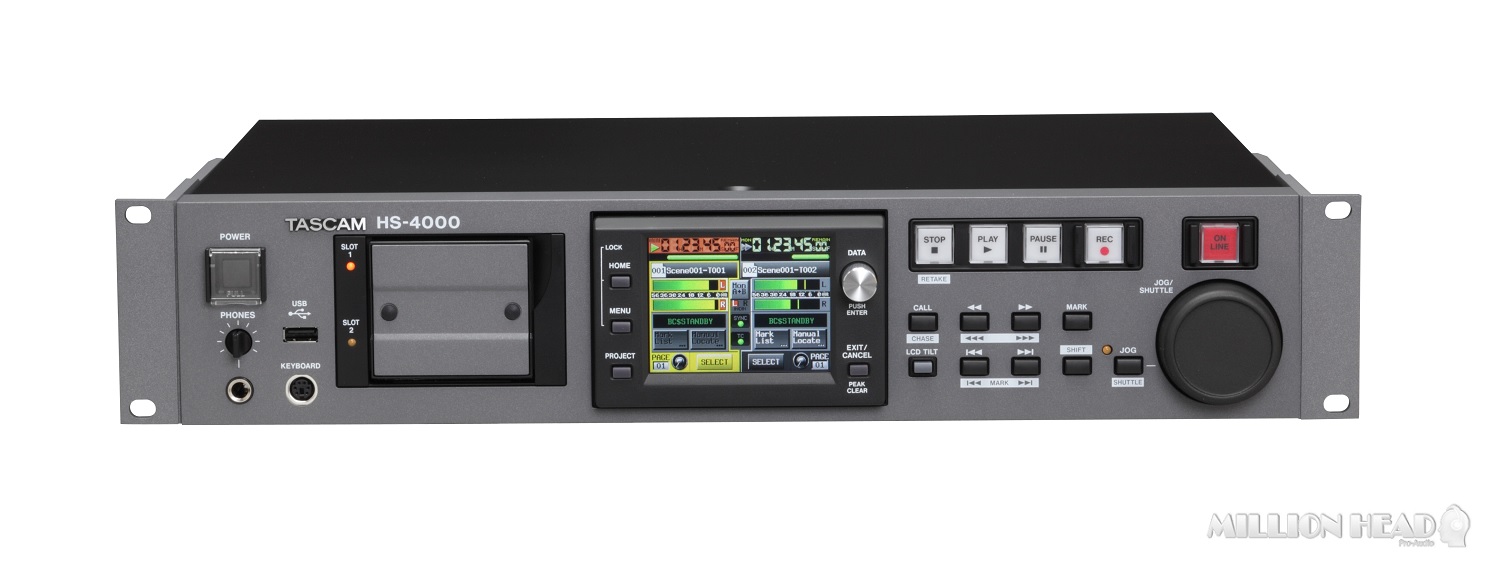
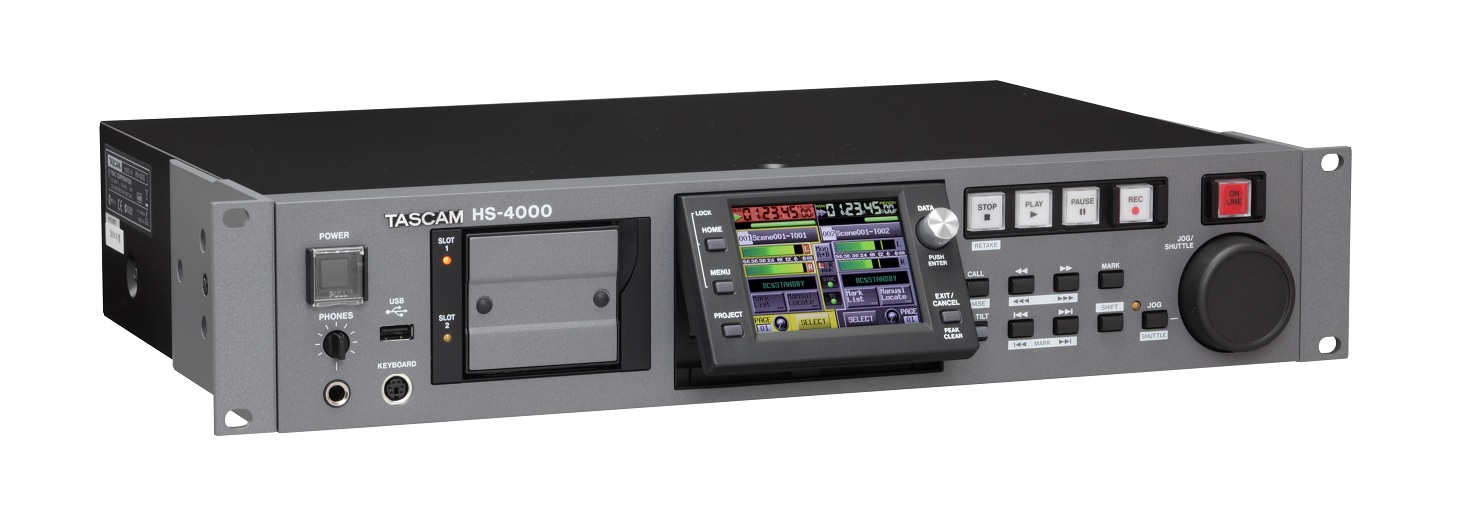

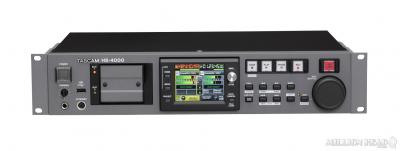
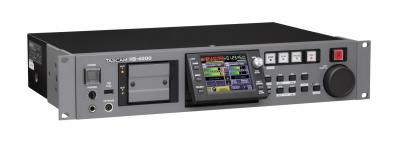


 บริการให้คำปรึกษา
บริการให้คำปรึกษา